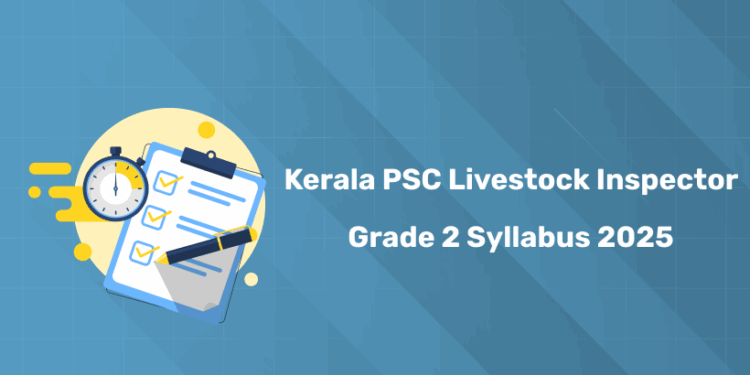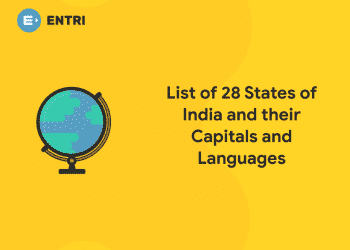Table of Contents
The Kerala PSC Livestock Inspector Grade II, Poultry Assistant, Milk Recorder, Store Keeper, and Enumerator exam syllabus has been released and the exam date announced. In this blog, we provide the complete syllabus and detailed exam pattern to help candidates prepare effectively for the Stage I common exam. Find all subjects, marks distribution, and important guidelines here.
Kerala PSC Livestock Inspector Grade 2 Exam 2025 Highlights
| Event | Details |
| Conducted By | Kerala Public Service Commission (PSC) |
| Post | Livestock Inspector Grade II, Poultry Assistant, Milk Recorder, Store Keeper, and Enumerator exams |
| Category No | 616/2024, 617/2024, 618/2024, 702/2024, 703/2024, 704/2024, 169/2025 & 141/2024 |
|---|---|
| Department | Animal Husbanadary |
| Exam Date | 27/10/2025 – MONDAY (7.00 AM to 8.50 AM) |
| Admit Card | 13/10/2025 |
| Mode of Exam | OMR (100 Marks) |
| Official Website | Kerala PSC Official Site |
Kerala PSC Live Stock Inspector Grade 2 Syllabus 2025 PDF Download
1: Which Year First Assembly Election was held in Kerala?
Candidates can download the Kerala PSC exam syllabus PDF for Livestock Inspector Grade II, Poultry Assistant, Milk Recorder, Store Keeper, and Enumerator (Open Market) from the link below. The PDF contains the complete subject-wise syllabus, topics, and marks distribution. Download now!
Enroll in Kerala's Top-rated Kerala PSC Coaching Program!
സർക്കാർ ജോലി എന്ന സ്വപ്നം ഇനി സ്വപ്നം മാത്രമല്ല! Join Entri's Kerala PSC Coaching Programs
Join Now!Kerala PSC Live Stock Inspector Grade 2 Exam Pattern 2025
The examination is for a total of 100 marks with 100 questions, meaning each question carries 1 mark. The test includes a negative marking scheme, where one-third of a mark (0.33) will be deducted for every wrong answer. The duration of the exam is 1 hour and 30 minutes. It will be conducted in English and the answers are to be marked on an OMR (Optical Mark Recognition) sheet.
| Module No. | Module Title | Marks |
|---|---|---|
| 1 | Introduction to Animal Husbandry | 5 |
| 2 | Breeds of Livestock | 10 |
| 3 | Rearing and Housing of Livestock | 8 |
| 4 | Bovine Management Practices | 15 |
| 5 | Breeding and Reproduction in Cattle | 12 |
| 6 | Husbandry of Goats, Pigs, and Rabbits | 8 |
| 7 | Poultry Husbandry | 25 |
| 8 | Management of Dogs and Cats | 5 |
| 9 | Livestock Products | 8 |
| 10 | Animal Welfare | 4 |
| Total | 100 |
Kerala PSC Live Stock Inspector Grade 2 Detailed Syllabus 2025
Module 1. Introduction to Animal Husbandry (5 Marks)
Common terminologies of Animal Husbandry: Different terms associated with the husbandry of cattle, buffalo, goat, sheep, pig, chicken, duck, turkey and quail) – gestation period – incubation period of eggs. Scientific names of cattle, buffalo, goat, sheep, pig, chicken, duck, turkey and quail.
Farming systems: Farming systems (mixed, diversified, organic, integrated) Anatomy and Physiology of animals: Definitions – Anatomical Peculiarities of liver, kidney, spleen and stomach of cattle, pig, chicken and dog – Structure of ruminant stomach – Process of ruminant digestion – Structure of mammary gland in cattle – Physiology of milk let down – Inhibition of milk let down – Hormonal role in lactation – Peak production and drying up.
Body parts of cattle and poultry: Different body parts (regions, body cavities, joints) Normal physiological values of animals: Normal range of temperature, pulse, respiration, rumen motility.
Farm records: importance of record keeping – important dairy farm records – important poultry farm records.
Personnel Protective Equipment: Risks associated with livestock farms – Personnel Protective Equipment (Goggles, Hard hat, Mask, Breathing apparatus, Gumboots)
Module 2. Breeds of Livestock (10 Marks)
Introduction to breeds: Definition of breed – Comparison of Indian and exotic breeds of cattle – Classification and comparison of breeds according to utility (Milch, Draught, Dual) – Definition of class, variety and strain of poultry.
Important breeds of cattle, buffalo, goat, sheep, pig, chicken, turkey, quail and duck: Origin and important breed characteristics of the following breeds – Sahiwal, Red Sindhi, Gir, Hallikar, Kangayam, Amrit Mahal, Kankrej, Hariana, Tharparkar, Vechur, Kasaragod dwarf, Jersey, Holstein Friesian, Brown Swiss, Murrah, Surti, Jaffarabadi, Mehsana, Nili Ravi, Nagpuri, Toda, Malabari, Attapady black, Barbari, Jamunapari, Sirohi, Saanen, Alpine, Boer, Kashmiri, Marwari, Merino, Large white Yorkshire, Landrace, Duroc, Berkshire, Hampshire, White leghorn, RIR, New Hampshire, Australorp, Plymouth rock, Cornish, Brahma, Cochin, Aseel, Kadaknath, Naked neck, Austro-white, Gramapriya, Athulya, Giriraja, Muscovy, White Pekin, Indian runner, Khakhi Campbell, Chara, Chemballi, Broad breasted bronze turkey, Beltsville
small white turkey, Japanese quail, Bobwhite quail.
Module 3: Rearing and Housing of Livestock (8 Marks)
Systems of rearing for cattle and poultry: Free range system, Intensive systems viz., Tail-to-tail system, Head-to-head system, Deep Litter system, Cage system, Semi intensive system) – Loose house system – Cow comfort and measures to ensure it – Effect of climate on animals and birds – (Homeostasis, Critical temperature, summer management measures) – Requirements and dimensions of a standard cattle shed (roofing, flooring, sidewalls, layout of tail-to-tail and headto-head systems) – Requirements and dimensions of a standard poultry shed (roofing, flooring, sidewalls) – Hi-tech dairy farm – Automation of cattle farm – Milking parlour – Solid and liquid waste disposal (biogas plant, vermi-composting, composting, slurry, organic mulch) – Culling and replacement.
Module 4: Bovine Management practices (15 Marks)
Neonatal calf care: Care of new borne calves – colostrum feeding – artificial respiration, cutting of umbilical cord, weaning of calves, feeding of calves, pail feeding, Deworming, Dehorning, nose rope application, pail feeding.
Feeding of cattle: Proximate principles (Digestible crude protein (D.C.P), metabolizable energy (M.E), total digestible nutrients (T.D.N) – Total Mixed Ration (TMR) – Classification of feed ingredients – Concentrate feed ingredients – Roughages – Unconventional feed stuff – Leguminous fodder (cow pea, subabul) – fodder preservation by Silaging (advantages of silage, types of silos, process of silage making, qualities of a good silage) – Hay making (steps of hay making, qualities of good hay) – bypass protein feed – Thump rules for feeding animals (maintenance, lactation, pregnancy allowances).
Health care of cattle: Definition of health and disease – Signs of health – Types of diseases – Etiology, symptoms and control measures of Anthrax, HS, BQ, TB, brucellosis, leptospirosis, rabies, Mastitis, lumpy skin disease) – Metabolic diseases (Milk fever, Ketosis) – parasitic diseases (Amphistomosis, tick infestation, mite infestation) – Phytotoxins (Hydrogen cyanide poisoning, Gossypol toxicity) – Biosecurity measures for disease control – Vaccination schedule
for cattle – Precautions for vaccination – Quarantine procedures – Disinfection and disinfestation – Carcass disposal methods – Management of wounds in animals – First aid measures for cattle and First aid kit – Measures to prevent mastitis – CMT- Dry cow therapy.
Restraining of Animals: Animal behaviour – Precautions while approaching the animal – Restraining of head, forelimbs, hind limbs – Precautions for casting – Casting using Reuff’s method – Casting using Alternate Method – Instruments used for controlling animals (anti-cow kicker, milk man’s rope, trevis, halter, mouth gag).
Identification of Animals: Hot iron branding – Chemical branding – Freeze branding – Tattooing – Tagging – Ear notching – Electronic chips/transponders.
Determination of age in cattle: Importance of age determination in cattle – Dental formula of cattle (permanent and deciduous) – Age determination using dentition – Age determination using horn rings.
Milking of cattle: Hand milking methods (full hand method, stripping, knuckling) – Machine milking – Parts of milking machine – Functioning of milking machine – Milking parlour system.
Module 5: Breeding and Reproduction in cattle (12 Marks)
Breeding of cattle: Genotype – Phenotype – Selection methods (Random selection, Individual selection, Family selection, Pedigree selection) – breeding methods (Grading-up, Progeny testing, In-breeding, Out-breeding, Cross breeding)
Reproduction in cattle: Structure and function of bovine female reproductive System – Structure and function of bovine male reproductive system – Hormonal interplay of female reproduction – Hormonal interplay of male reproduction – Sexual maturity and puberty – Estrus cycle – Heat signs of cattle – Heat detection methods – Semen collection using artificial vagina and examination of semen quality (Macroscopic and Microscopic) – Semen extenders and preservation (Coconut milk extender, Egg-yolk citrate, Liquid Nitrogen) – Equipment used for A.I. – Recto-vaginal method of A.I. – Speculum method of A.I. – Pregnancy diagnosis – Stages of parturition – Signs of calving – Dystocia – Service period – Inter-calving period – Dry period – Multiple Ovulation and Embryo Transfer (MOET) – Infertility in cattle.
Module 6: Husbandry of Goats, Pigs and Rabbits (8 Marks)
Goat Husbandry: Advantages of goat rearing – Housing requirements of goats – Feeding of goats – Care and management of kids – Care and management of pregnant does – Care and management of lactating does – Management of bucks – Signs of heat in goat – A.I. in goat – common diseases of goats (PPR, CCPP, Tetanus, PEM)
Swine Husbandry – Advantages and disadvantages of pig farming – Housing of pigs – Care and management of piglets – Care of farrowing sow
Care of Rabbits: Housing rabbits – Feeding of rabbits – Coprophagy – Sex differentiation in rabbits – Breeding of rabbits – Care of pregnant rabbits – Care new born kits – Diseases of rabbits (Pasteurellosis, sore hock, mange, hair balls).
Module 7: Poultry Husbandry (25 Marks)
Introduction to poultry husbandry: Merits and demerits of poultry rearing – Identification methods for poultry.
Anatomy and physiology of chicken: Digestive system – Female reproductive system – Respiratory system – Physiology of egg formation – Effect of light on egg production – Molting and bleaching.
Feeding of chicken – Common ingredients used for the formulation of poultry feed – Feeding systems of poultry (Adlibitum feeding, Restricted feeding, Mash feeding, Pelleted feeding) -Feed efficiency in layers and broilers – Feed additives – Different types of feeders and waterers -Average requirement of total feed for chicks, growers, layers and broilers.
Poultry management: Management of chicks (Brooding, brooder set up, brooder management) – Grower management – Layer management (factors affecting egg production, differentiating good and poor layers, Managemental practices for producing good quality eggs, Hen day and Hen housed egg production standards) – General management of breeders (Mating methods, Artificial insemination in chicken, Trap nesting) – Broiler management.
Hatchery Management: Structure of egg – Abnormal eggs (Double yolked egg, an egg within an egg, pale egg, soft shelled egg, blood spot, meat spot) – Candling and grading of eggs – Selection of hatching eggs – Incubator management (parts of incubator, pre-requisites for egg incubation) – Hatchery operations (Collection of eggs, fumigation, setting, identification methods for birds, sexing of chicks, dubbing, debeaking, disposal of hatchery waste).
Diseases of chicken: Etiology, important symptoms and preventive measures (Pasteurellosis, Salmonellois, New castle disease (NCD), Fowl pox, Marek’s disease (MD), Infectious bursal disease (IBD), Avian influenza, Aspergillosis, Coccidiosis, Ascaridia galli infection, Lice and mite infestations, Rickets, Nutritional roup, Curled toe paralysis, Crazy chick disease) – Vaccination and vaccination Schedule – Litter management – Biosecurity measures for a poultry farm.
Husbandry of ducks: Advantages of duck rearing – Housing, feeding and management of ducks – Sex differentiation – Duck diseases (Pasteurellosis, Duck plague, Duck hepatitis, Aflatoxicosis)
Husbandry of Turkey: Housing, feeding and management of Turkey – Care of poults – Sex differentiation – Diseases of turkey and health care (Pasteurellosis, Black head disease) Husbandry of quail: Advantages of quail rearing – Housing, feeding and management of quail – Sex differentiation – Diseases of quail and health care (Quail enteritis).
Module 8: Management of dogs and cats (5 Marks)
Management of dogs: Important breeds of dogs (German Shepherd, Labrador, Doberman, Rottweiler, Japanese spitz, Pug) – Restraining of dogs – Selection of pups – Grooming – Feeding of dogs – Breeding of dogs – Basic awareness on diseases of dogs (Rabies, Canine distemper, Parvo viral enteritis) -Vaccination schedule of dogs – Deworming – Care of pups.
Management of cats: Important breeds of cats (Persian, Burmese) – Restraining of cats – Feeding of cats.
Module 9: Livestock products (8 Marks)
Egg: Nutritive value of egg – Structure of egg – Preservation of egg (Chilling, freezing, pickling, water glass method, lime sealing) – commercial egg products (whole egg powder, albumen powder)
Milk: Nutritive value of milk – Classification of milk products (acid coagulated, fermented, fat rich, by-products, frozen products) – methods preservation of milk (Pasteurization, sterilization, chilling) – Types of milk commercially available (Toned milk, double toned milk, Homogenized milk, Condensed milk) – basics of preparation of various types of milk products (Paneer, Chhana, Khoa, Dahi, Cheese, Ghee, Cream, Whey, Skim milk, Ice cream)
Wholesome milk production – Sources of contamination of milk – Measures to produce clean milk – Adulteration of milk (starch, formaline, cane sugar, water) – Measurement of specific gravity using lactometer.
Meat: Nutritive value of meat – Preservation of meat (Chilling, freezing, thermal processing, canning, curing, smoking, irradiation) – Meat products (Sausage, meat cutlet, nuggets)
Module 10: Animal welfare (4 Marks )
Animal welfare and Animal rights – Types of animal freedom – Prevention of cruelty to animals (PCA) act (Purpose, general cruelties to animals) – Guidelines related to transportation of animals (By foot, by road and by rail) – 3 Rs of Animal welfare – Human-Animal conflicts.
How to Download Kerala PSC Live Stock Inspector Grade 2 Syllabus
To download the Livestock Inspector Grade 2 syllabus from the Kerala PSC site, follow these steps:
- Visit the Kerala PSC website: https://www.keralapsc.gov.in
- Go to the Recruitment Section: Click on “Recruitment” in the main menu.
- Find Syllabus: Look for “Syllabus” under the recruitment or notifications section.
- Select the Exam: Choose “Livestock Inspector Grade 2” from the list of available exams.
- Download: Click on the Download link or PDF icon to save the syllabus to your device.










